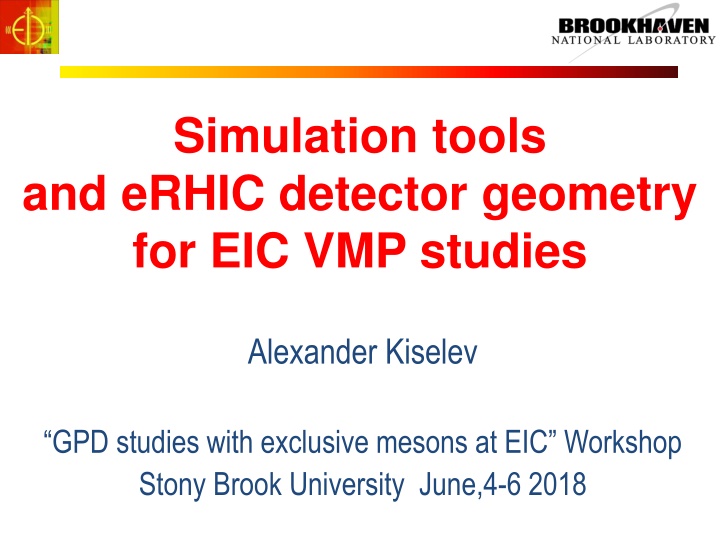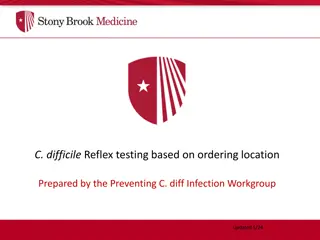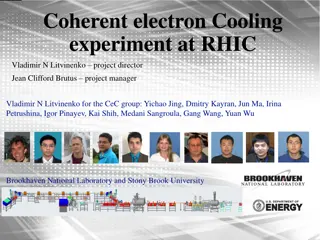
Advanced Simulation Tools and Detector Geometry for EIC Studies
Explore the utilization of simulation tools and eRHIC detector geometry for EIC VMP studies and GPD studies with exclusive mesons. Discover the BeAST main detector geometry, EicRoot framework, available functionality, and simulation usage options for comprehensive insights into experimental physics at EIC.
Download Presentation

Please find below an Image/Link to download the presentation.
The content on the website is provided AS IS for your information and personal use only. It may not be sold, licensed, or shared on other websites without obtaining consent from the author. If you encounter any issues during the download, it is possible that the publisher has removed the file from their server.
You are allowed to download the files provided on this website for personal or commercial use, subject to the condition that they are used lawfully. All files are the property of their respective owners.
The content on the website is provided AS IS for your information and personal use only. It may not be sold, licensed, or shared on other websites without obtaining consent from the author.
E N D
Presentation Transcript
Simulation tools and eRHIC detector geometry for EIC VMP studies Alexander Kiselev GPD studies with exclusive mesons at EIC Workshop Stony Brook University June,4-6 2018
Outline BeAST main detector geometry and modeling tools eRHIC Interaction Region (IR) modeling environment ... ... and a couple of selected results Outlook
EicRoot framework in one slide Interface to GEANT, ROOT, FairBase PandaRoot FopiRoot TPC R&D stuff, Ideal track finder, Interface to GenFit EicRoot CbmRoot eic-smear MC generated evts import Fast smearing codes RICH stuff solenoid modeling IR design configuration
Available functionality Flexible MC event import Various generator ASCII output files (MILOU, PYTHIA, ...), binary formats: (TPythia, ...) Vertex smearing, kinematics adjustment (22mrad crossing angle), ... Modular geometry Reasonably good track reconstruction ... ... and much less functional calorimetry codes Several advances in the IR description Main detector and forward-acceptance detectors are treated at once Recoil proton goes to B0 silicon tracker or to the RPs Scattered electron (& say + - pair) - to the main detector
BeAST model detector in EicRoot -3.5 < < 3.5: Tracking & e/m Calorimetry (hermetic coverage) hadronic calorimeters e/m calorimeters RICH detectors Momentum resolution 7 /P [%] 50 GeV/c 25 GeV/c 10 GeV/c 1 GeV/c 6 P s Momentum resolution 5 4 3 2 1 0 -3 -2 -1 0 1 2 3 Pseudo-rapidity silicon trackers TPC GEM trackers Micromegas barrels 3T solenoid cryostat magnet yoke An update incorporating IR vacuum system design is in progress
Simulation usage options 1) Download & compile EicRoot from scratch 2) Download pre-packaged EicRoot Docker container simulation digitization reconstruction PID; assembly -> Hits -> Tracks, clusters -> Events -> MC points 3) Wait until EIC Sandbox framework grand-unification environment is set up -> first version as early as June this year? 4) Use EIC smearing generator package (eic-smear) instead?
EIC smearing generator Built-in standard smearers provided with eic-smear Users can define own smearers using inheritance Smearer defines some element of performance + acceptance Detector Smearer NOT a physical detector : represents the overall performance in measuring a quantity. Smearer Apply all smearers to an MC event Yield smeared event Optionally recalculate derived values e.g x, Q2 Smearer Smearer Smearer Think of it as a parametric filter, which acts on imported MC events
EIC smearing generator Easy to install & use No external dependencies other than ROOT ASCII generator file import is readily available The main idea: once detector acceptance regions and resolutions of kinematic variables are determined via complete GEANT simulation & subsequent reconstruction (by somebody else), for rough basic estimates it may suffice to use a collection of parameterized detectors rather than running the full simulations
EIC smearing generator Tree code: Build ROOT tree containing events Smearer: Perform fast detector smearing MC generator ASCII output Large number of EIC Monte Carlo generators with standard ASCII format PYTHIA DPMJet PEPSI Milou gmc_trans Rapgap LEPTO Djangoh NB: both event import and smearing functionality is supported in EicRoot
eRHIC IR hadron-going direction Back to the full GEANT simulations Will focus on B0 magnet, RPs & ZDC
eRHIC IR simulation environment Pump stand ghost volume B0 e Main tracker Q2E Q1H B0 Si tracker ROOT event display p Beam line element apertures and magnetic fields (.madx files) Vacuum system engineering drawings (ground CAD .stp import) Either boolean decomposition or STL->tetrahedrons dump or just a ghost shape B0 large-acceptance dipole design (COMSOL .mphtxt import)
Pt acceptance for DVCS protons Plots: HD (high divergence) case Events 450 275 x 18 GeV 400 350 ~10 away from beam line Q2E 300 250 200 150 RP 100 20mrad vacuum pipe 50 B0 Si tracker 0 0 0.2 0.4 0.6 0.8 1 1.2 1.4 DVCS proton P [GeV/c] t Events 450 100 x 10 GeV 400 p 350 300 first quad aperture & beam pipe 250 200 B0 150 100 50 vacuum chamber exit window 0 0 0.2 0.4 0.6 0.8 1 1.2 1.4 DVCS proton P [GeV/c] t Events 350 41 x 5 GeV 300 Gap between RP and B0 will be further optimized Low-Pt part can be filled in with HA-running 250 vacuum system ~20mrad cone 200 150 B0 100 50 achieve at least 0.3 GeV < pt < 1.3 GeV range 0 0 0.2 0.4 0.6 0.8 1 1.2 1.4 DVCS proton P [GeV/c] t
Angular acceptance for charged tracks ~[ 0 .. 5] mrad: Roman Pots ~[ 5 .. 7] mrad: gray zone ~[ 7 .. 20] mrad: B0 forward large-acceptance spectrometer ~[20 .. 50] mrad: gray zone From ~50 mrad or so ( ~ 3.5): main tracker
Pt resolution for recoil protons B0 magnet [100 GeV/c beam energy @ pt ~ 1.3 GeV/c (worst case)] (~1.3T field, ~1.2m long; 4 Si stations with ~20 m resolution; Kalman fllter) ~30 MeV/c without IP vertex constraint ~15 MeV/c with reasonable assumptions about beam envelope size at the IP Roman Pots [275 GeV/c beam energy] (2 stations ~30m from IP, 20cm apart, ~20 m resolution; matrix transport) ~20 MeV/c at ~ 0 degrees (recoil in horizontal plane) ~10 MeV/c at ~ 90 degrees (recoil in vertical plane) NB: these estimates do not include beam divergence at the IP
Angularacceptance for neutrons ZDC NB: here particles generated flat in ZDC is handled as a black hole volume B2A Q3E p Events 2000 1800 1600 1400 B1 4mrad 1200 e 1000 800 Q2H ACCEPTED 600 400 Q2E 200 Q1H 0 0 1 2 3 4 5 6 7 8 9 10 Scattering angle, [mrad] NB: space for ZDC needs to be increased for better hadronic shower containment B0 Main tracker Achieve the 4 mrad acceptance requirement
Summary & Outlook Main detector geometry and IR geometry bits a pieces (basic vacuum chamber blocks, quad & dipole volumes, simplified magnetic fields, etc) can be imported in a full GEANT environment and used at once ... ... otherwise smearing generator fast simulation tool is available Recently the GEANT codes were used for eRHIC IR design validation Eventually: use unique source of geometry & other input info for Physics simulations Detector performance benchmarks Beam-gas machine background studies Synchrotron background studies Neutron flux and radiation dose estimates




















